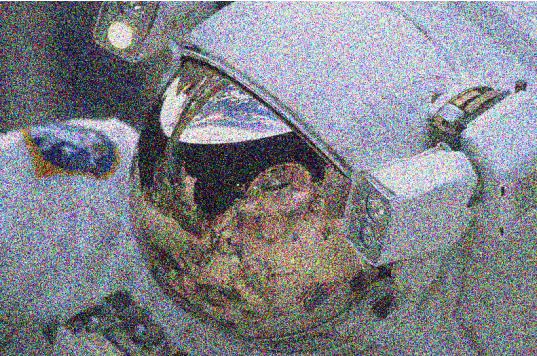 | ||
In signal processing, the Wiener filter is a filter used to produce an estimate of a desired or target random process by linear time-invariant (LTI) filtering of an observed noisy process, assuming known stationary signal and noise spectra, and additive noise. The Wiener filter minimizes the mean square error between the estimated random process and the desired process.
Contents
Description
The goal of the Wiener filter is to compute a statistical estimate of an unknown signal using a related signal as an input and filtering that known signal to produce the estimate as an output. For example, the known signal might consist of an unknown signal of interest that has been corrupted by additive noise. The Wiener filter can be used to filter out the noise from the corrupted signal to provide an estimate of the underlying signal of interest. The Wiener filter is based on a statistical approach, and a more statistical account of the theory is given in the minimum mean square error (MMSE) estimator article.
Typical deterministic filters are designed for a desired frequency response. However, the design of the Wiener filter takes a different approach. One is assumed to have knowledge of the spectral properties of the original signal and the noise, and one seeks the linear time-invariant filter whose output would come as close to the original signal as possible. Wiener filters are characterized by the following:.
- Assumption: signal and (additive) noise are stationary linear stochastic processes with known spectral characteristics or known autocorrelation and cross-correlation
- Requirement: the filter must be physically realizable/causal (this requirement can be dropped, resulting in a non-causal solution)
- Performance criterion: minimum mean-square error (MMSE)
This filter is frequently used in the process of deconvolution; for this application, see Wiener deconvolution.
Wiener filter solutions
The Wiener filter problem has solutions for three possible cases: one where a noncausal filter is acceptable (requiring an infinite amount of both past and future data), the case where a causal filter is desired (using an infinite amount of past data), and the finite impulse response (FIR) case where a finite amount of past data is used. The first case is simple to solve but is not suited for real-time applications. Wiener's main accomplishment was solving the case where the causality requirement is in effect, and in an appendix of Wiener's book Levinson gave the FIR solution.
Noncausal solution
where
and the solution
Causal solution
where
This general formula is complicated and deserves a more detailed explanation. To write down the solution
- Start with the spectrum
S x ( s ) in rational form and factor it into causal and anti-causal components:S x ( s ) = S x + ( s ) S x − ( s ) whereS + S − - Divide
S x , s ( s ) e α s S x − ( s ) and write out the result as a partial fraction expansion. - Select only those terms in this expansion having poles in the LHP. Call these terms
H ( s ) . - Divide
H ( s ) byS x + ( s ) . The result is the desired filter transfer functionG ( s ) .
Finite impulse response Wiener filter for discrete series
The causal finite impulse response (FIR) Wiener filter, instead of using some given data matrix X and output vector Y, finds optimal tap weights by using the statistics of the input and output signals. It populates the input matrix X with estimates of the auto-correlation of the input signal (T) and populates the output vector Y with estimates of the cross-correlation between the output and input signals (V).
In order to derive the coefficients of the Wiener filter, consider the signal w[n] being fed to a Wiener filter of order N and with coefficients
The residual error is denoted e[n] and is defined as e[n] = x[n] − s[n] (see the corresponding block diagram). The Wiener filter is designed so as to minimize the mean square error (MMSE criteria) which can be stated concisely as follows:
where
To find the vector
Assuming that w[n] and s[n] are each stationary and jointly stationary, the sequences
The derivative of the MSE may therefore be rewritten as (notice that
Letting the derivative be equal to zero results in
which can be rewritten in matrix form
These equations are known as the Wiener–Hopf equations. The matrix T appearing in the equation is a symmetric Toeplitz matrix. Under suitable conditions on
Relationship to the least squares filter
The realization of the causal Wiener filter looks a lot like the solution to the least squares estimate, except in the signal processing domain. The least squares solution, for input matrix
The FIR Wiener filter is related to the least mean squares filter, but minimizing the error criterion of the latter does not rely on cross-correlations or auto-correlations. Its solution converges to the Wiener filter solution.
Applications
The Wiener filter has a variety of applications in signal processing, image processing, control systems, and digital communications. These applications generally fall into one of four main categories:
For example, the Wiener filter can be used in image processing to remove noise from a picture. For example, using the Mathematica function: WienerFilter[image,2] on the first image on the right, produces the filtered image below it.
It is commonly used to denoise audio signals, especially speech, as a preprocessor before speech recognition.
History
The filter was proposed by Norbert Wiener during the 1940s and published in 1949. The discrete-time equivalent of Wiener's work was derived independently by Andrey Kolmogorov and published in 1941. Hence the theory is often called the Wiener–Kolmogorov filtering theory (cf. Kriging). The Wiener filter was the first statistically designed filter to be proposed and subsequently gave rise to many others including the Kalman filter.
